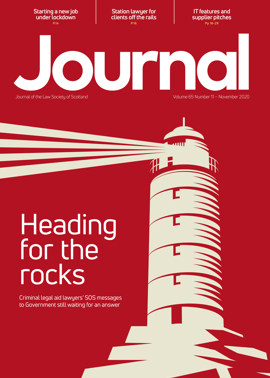Pensions: The future – the regulator's blueprint
 Some 15 years since its inception, the Pensions Regulator (“TPR”) has commenced a conversation with stakeholders on its provisional strategy for the next 15 years. In its consultation Pensions of the Future – A Discussion on our Strategy, TPR outlines its commitment to savers and the five strategic priorities and high-level goals it has identified for potential future focus. TPR is concerned that in an ever-changing world it too evolves as society, the economy, Government policy and its priorities change.
Some 15 years since its inception, the Pensions Regulator (“TPR”) has commenced a conversation with stakeholders on its provisional strategy for the next 15 years. In its consultation Pensions of the Future – A Discussion on our Strategy, TPR outlines its commitment to savers and the five strategic priorities and high-level goals it has identified for potential future focus. TPR is concerned that in an ever-changing world it too evolves as society, the economy, Government policy and its priorities change.
Objectives and role
TPR’s six statutory objectives are:
- to protect the benefits of members of occupational schemes;
- to protect the benefits of members of personal pension schemes where direct payment arrangements are in place;
- to reduce the risk of situations arising which may lead to compensation being payable from the Pension Protection Fund;
- in relation to its functions for defined benefit (“DB”) scheme funding only, to minimise any adverse impact on the sustainable growth of an employer;
- to maximise compliance with employer duties and the employment safeguards introduced by the Pensions Act 2008; and
- to promote, and to improve understanding of, the good administration of work-based pension schemes.
Bearing these in mind, being clear as to its role and how it prioritises its work is seen as key.
Reflecting on the shift from DB schemes to defined contribution (“DC”) schemes over the last 15 years, accelerated with implementation of the auto-enrolment regime, TPR considers its focus must change from a scheme based view to one focused on the saver, protecting the savings outcomes of those in retirement or entering retirement in the next 15 years, and for those further away from retirement on driving participation and enhancing outcomes.
With that in mind, TPR differentiates various cohorts of savers and suggests what might be key areas of specific focus over the next 15 years, including:
Baby Boomers (born between 1946 and 1964)
Having historically saved into pensions more than other generations, most commonly through DB schemes, this relatively financially secure generation will complete their move into retirement. TPR considers its key areas of focus will include:
- security and value in DB schemes;
- working with partners to prevent and tackle pension scams; and
- understanding and enabling good saver decision-making.
Generation X (born between 1965 and 1984)/Millennials (born between 1985 and 2004)
With these generations of savers having no or reducing access to DB schemes and in general a reducing ability and appetite to make pension savings, TPR considers its core objective for these savers, in all income brackets, to be to enhance their savings outcomes with key areas of focus, including:
- driving participation in workplace pensions;
- ensuring that savers get value from their pensions and that their money is secure; and
- encouraging and supporting innovation.
Generation Z (born 2005 onwards)
Recognising that over the course of its new strategy this generation will be entering the employment market, TPR’s focus will be to evolve to meet the needs of those new savers.
The pensions landscape
Consideration is given to the pensions landscape and how it might evolve. TPR’s analysis suggests it will be regulating fewer but larger schemes of all types as the market consolidates (suggesting 50% fewer DC schemes, and around a third fewer DB). In all this, it sees the following trends as impacting:
- further changes in the nature of work and retirement;
- shifts in the trustee model, types of benefit and market place;
- the proportion of DB memberships and assets continuing to reduce;
- DC market continuing to grow and consolidating;
- suppliers innovating and integrating;
- technology driving and enabling change;
- evolution of regulatory frameworks.
With that in mind, TPR suggests five strategic priorities, each with a strategic goal as follows:
- security: ensuring savers’ money is secure;
- value for money: ensuring savers get good value for money;
- scrutiny of decision making: ensuring decisions made on behalf of savers are in their best interests;
- embracing innovation: encouraging the market to innovate;
- bold and effective regulation: TPR being a bold and effective regulator.
- TPR is looking to discuss its thoughts and ideas with stakeholders, with a view to publishing its strategy in the new year.
It is to be hoped that there will be high levels of stakeholder engagement, with a view to identifying the most efficient and effective means of delivering these strategic goals. For an increasing number of savers, it is clear that outcomes will depend on provision in larger consolidated DC arrangements, and the extent to which the auto-enrolment regime is developed. For TPR the trick will be to regulate sensitively in what will be a further period of transition, in a way that enhances rather than undermines the retirement outcomes of savers.
Regulars
Perspectives
Features
Briefings
- Civil court: keeping justice on the rails
- Employment: Time for a redundancy refresher
- Family: Watch your step with behaviour-based divorce
- Human rights: Inner House message in privacy group chat
- Pensions: The future – the regulator's blueprint
- Scottish Solicitors' Discipline Tribunal
- Crofting law reform: time to act
- In-house, online and in demand
In practice
- Paralegals: 10 years of recognition
- Ask Ash: Too busy, but still insecure
- Property pitfalls: problematic but preventable
- The Word of Gold: Count us out
- Prepare for the tax due date
- The Eternal Optimist: Help to turn the corner
- Appreciation: Ross Paton
- Appreciation: Claire Reilly (Robertson)
- Tenancies succession reminder







